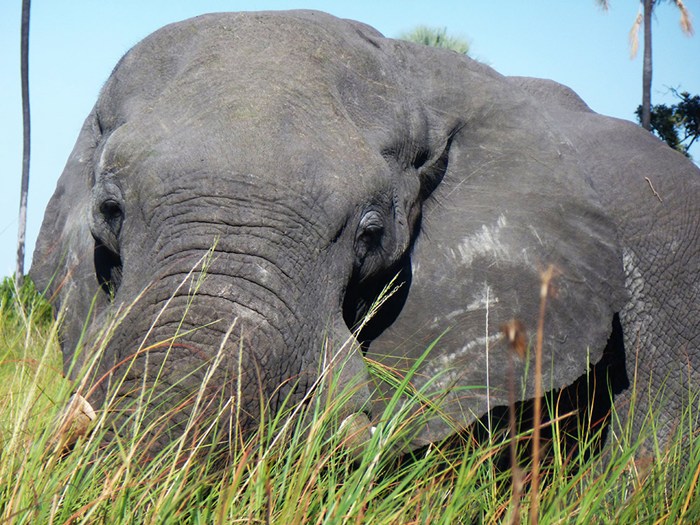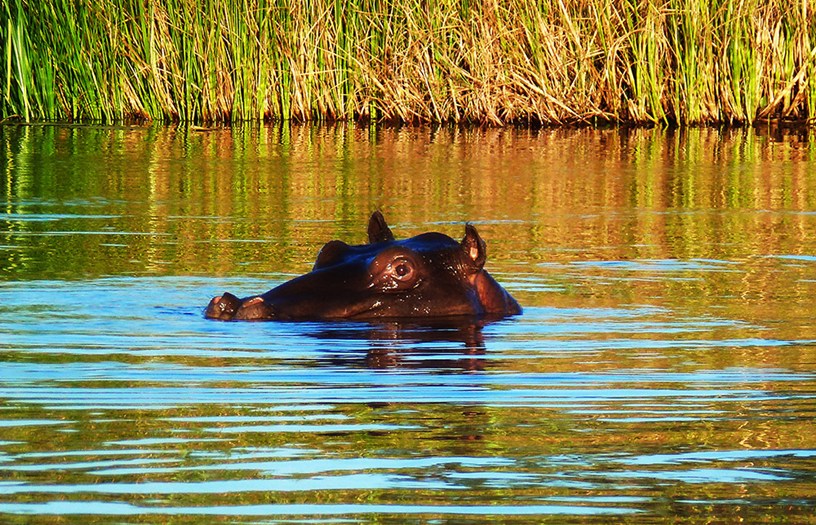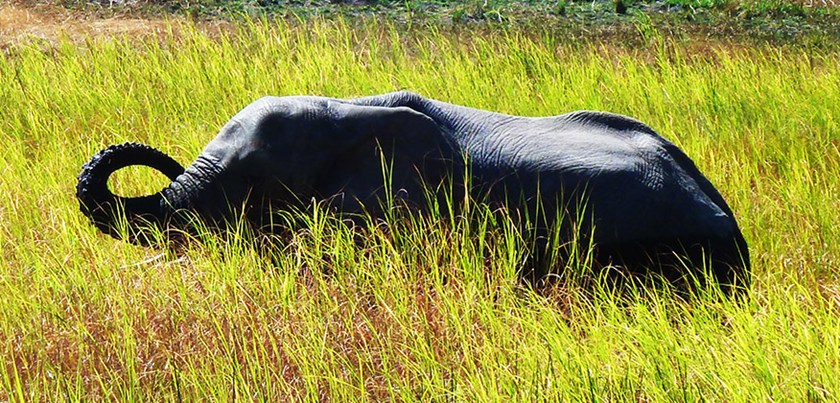OKAVANGO DELTA, BOTSWANA - I love elephants. I have ridden them in India and played with them at sanctuaries in Thailand. So I was thrilled when on a journey through Botswana our small plane began its descent to the Okavango Delta airstrip and I could see clusters of the gentle giants munching contentedly on tender shoots growing in the marshy waters.
Our group left the hot, dusty city of Maun (pronounced Maw-oon) early that morning. Known as the “gateway to the Okavango Delta,” Maun is a charmless place full of hulking overland tour vehicles that stop for supplies before continuing north to Cairo or south to Capetown. The only thing appealing about it were the chickens and goats freely roaming the sidewalks. Roughly the size of France, Botswana has a population of two million and 70 per cent of its territory is desert.
In contrast, the Okavango Delta, in the northwest corner of the country, is a rich green oasis. One of the world’s largest inland deltas, it is a labyrinth of lagoons, lakes and hidden channels covering 17,000 square kilometres. The water starts out in the Angolan highlands, flows through Namibia, and once past the Botswana border, widens into a triangular-shaped delta. Millions of years ago it flowed into a large inland lake that has since dried up and become the Makgadikgadi Salt Pans. Tectonic activity and faulting blocked the river’s flow southward, causing it to back up and form the delta.
After 20 minutes in the air, we were greeted on the landing strip by staff from our lodge, Moremi Crossing. A 20-seat powerboat took us through a grassy channel to the dock. We trudged up the path and all of a sudden Moremi Crossing’s lobby stretched before us — a tall, wall-less structure with a dramatic thatched roof. As well as the check-in counter there were couches scattered about, a wildlife viewing platform, a bar and dining tables. Our guest accommodations were down further boardwalk paths — 16 permanent, two-person luxury tents overlooking the water with wooden floors, porch, and washroom with outdoor shower. My bathroom sink was decorated with elephants.
The pace at Moremi Crossing agreed with me. In the morning we rode in dugout canoes through the grassy waterways. Stashing the boats on the shore of a nearby island, we struck out on a wildlife hike and spotted giraffes, zebras and warthogs. The only sign of the elephants was a dung heap and footprints the size of a large pizza. Back at the lodge, we savored a brunch of salad, quiche, fresh baked bread, creamy cheeses and pineapple for dessert. After that it was nap time. Dozing in the hammock on my porch, I heard a crunch and opened my eyes. Something was moving in the bushes. Swish, swish. It was a tail, attached to a very large elephant. I froze. He nonchalantly strolled right by my tent. I jumped out of the hammock and leaned over to see the back of him disappear down a leafy path. Seconds later I heard shouts and claps. One of the staff was laughing and shooing him away from the lodge. My heart was pounding and my smile was a mile wide. The big fella had come to see me. Well, kinda. Of course my camera had been stowed inside the tent the whole time.

Above: Seeing an elephant up close like this is a thrilling experience.
Over a delicious dinner of butternut squash soup, Botswana beef, pap (a white porridge-like dish made with corn, similar to grits), chakalaka (a spicy relish of beans, peppers, carrots and tomatoes), salad and apricot mousse, I told my fellow travellers about my visitor. “Better watch out, I think you have a new boyfriend,” joked Kayleen, a retired teacher from Melbourne.
Our days were spent exploring. One afternoon we took a powerboat safari and passed a cape buffalo lounging by the water. “If they are alone, they can be very dangerous,” our guide explained. We kept our distance and as soon as he saw us he ran full speed in the opposite direction. Bobbing along a narrow channel, we hushed as the guide held up his hand and cut the motor. Suddenly, five metres from the boat, two eyes and a pair of little round ears popped up. “Hippos may look like jolly fellows, but they are not,” said the guide. “If they feel threatened, they will charge. Hippos cause a lot of deaths,” he explained. We gave Mr. Hippo a wide berth and continued on our way. Other sightings included baboons, antelope and a crocodile. The Okavango Delta has one of the richest pack densities of wild dogs in Africa. Endangered, the dogs travel in packs of around 13 and are bigger than a leopard. We didn’t see any dogs, or leopards, though.


Left: A rhino sunbathing in a shallow river. Right: An elephant roaming through the tall grass.
Looking up, we did see some of the region’s feathered residents. Binoculars were passed around as we spied gorgeous lilac-breasted rollers, multi-coloured bee-eaters, black-collared barbets, hoopoes, crimson-breasted shrik, and magnificent fish eagles with two metre wingspans.
On the last day, I hung about the viewing platform with my binoculars, scouting the grasses for a sight of my big, grey boyfriend. No such luck. All was quiet except for some birdsong. When I could delay no longer, I brought my bags down to the dock and boarded the boat, heading back to the airstrip. As we puttered along, I reflected on my stay. It had been spectacular. Especially seeing a wild elephant so close up. We turned a bend and it was him. Standing knee-deep in water, he was tugging marsh shoots and delicately placing them in his mouth. The boat slowed and we stared at each other. He almost seemed to be smiling. I grinned back. What a sweet goodbye.
About the Author
A Toronto-based traveller, writer and communications specialist, Maureen combines her wanderlust with a drive to do good in the world. When she is not gazing at the Northern Lights in Norway, sweating in a Mexican temazcal or stroking the soft fur of lion cubs in South Africa for a story, Maureen can be found sharing her expertise and building the capacity of people in developing countries. From buying produce in the local markets to checking out a new city's hidden nooks and crannies, she revels in soaking up the culture and savouring the cuisine. Her award-winning articles reflect her natural curiosity and love of life, no matter where she happens to be.